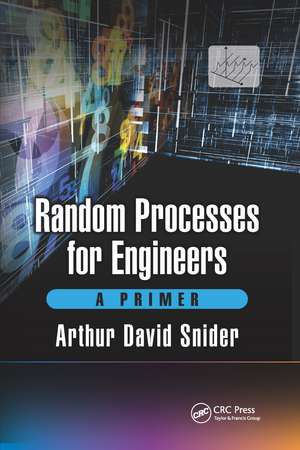Random Processes for Engineers: A Primer
Autor Arthur David Snideren Limba Engleză Paperback – 30 sep 2020
Preț: 274.79 lei
Nou
Puncte Express: 412
Preț estimativ în valută:
52.61€ • 53.97$ • 44.30£
52.61€ • 53.97$ • 44.30£
Carte disponibilă
Livrare economică 05-19 februarie
Livrare express 21-25 ianuarie pentru 44.21 lei
Preluare comenzi: 021 569.72.76
Specificații
ISBN-13: 9780367656355
ISBN-10: 0367656353
Pagini: 207
Dimensiuni: 156 x 234 x 25 mm
Greutate: 0.66 kg
Ediția:1
Editura: CRC Press
Colecția CRC Press
ISBN-10: 0367656353
Pagini: 207
Dimensiuni: 156 x 234 x 25 mm
Greutate: 0.66 kg
Ediția:1
Editura: CRC Press
Colecția CRC Press
Cuprins
Probability Basics. Random Processes. Analysis of Raw Data. Models for Random Processes. Least Mean-Square Error Predictors. The Kalman Filter.
Notă biografică
Dr. Arthur David Snider has over fifty years of experience in modeling physical systems in the areas of heat transfer, electromagnetics, microwave circuits, and orbital mechanics, as well as the mathematical areas of numerical analysis, signal processing, differential equations, and optimization. He holds degrees in both mathematics (BS, MIT, PhD, NYU) and physics (MA, Boston U), and he is a registered professional engineer. He served for forty-five years on the faculties of mathematics, physics, and electrical engineering at the University of South Florida after working for five years as a systems analyst at MIT's Draper Instrumentation Lab. He consults in many industries in Florida and has published five other textbooks in applied mathematics.
Recenzii
"This is great and timely book! It takes difficult concepts and distills them to the reader in a way that is simple and easy to understand. It connects students with hard to understand theories and concepts though the use of good examples and graphical illustrations."
— George Edwards, University of Denver, USA
"This book offers an intuitive approach to random processes and discusses how to interpret and predict their behavior. Based on the idea that new techniques are best introduced by specific, low-dimensional examples, the mathematical exposition is made easier to comprehend and serves to motivate the subsequent generalizations. It distinguishes between the science of extracting statistical information from raw data such as a time series about which nothing is known a priori and that of analyzing specific statistical models, such as Bernoulli trials, Poisson queues, ARMA, and Markov processes. The former motivates the concepts of statistical spectral analysis (such as the Wiener–Khintchine theory), and the latter applies and interprets them in specific physical contexts. The Kalman filter is introduced in a simple scalar context, where its basic strategy is transparent and gradually extended to the full-blown iterative matrix form."
—IEEE Control Systems Magazine, December 2017 Issue
— George Edwards, University of Denver, USA
"This book offers an intuitive approach to random processes and discusses how to interpret and predict their behavior. Based on the idea that new techniques are best introduced by specific, low-dimensional examples, the mathematical exposition is made easier to comprehend and serves to motivate the subsequent generalizations. It distinguishes between the science of extracting statistical information from raw data such as a time series about which nothing is known a priori and that of analyzing specific statistical models, such as Bernoulli trials, Poisson queues, ARMA, and Markov processes. The former motivates the concepts of statistical spectral analysis (such as the Wiener–Khintchine theory), and the latter applies and interprets them in specific physical contexts. The Kalman filter is introduced in a simple scalar context, where its basic strategy is transparent and gradually extended to the full-blown iterative matrix form."
—IEEE Control Systems Magazine, December 2017 Issue
Descriere
This book discusses the statistical description of processes, including an extensive review of probability and statistics and the analysis of raw data using spectral methods. Various theoretical models (ARMA, Bernoulli, shot, Markov, and random walks) are explored, as well as techniques that are used for prediction—least mean-squared error, Wien










